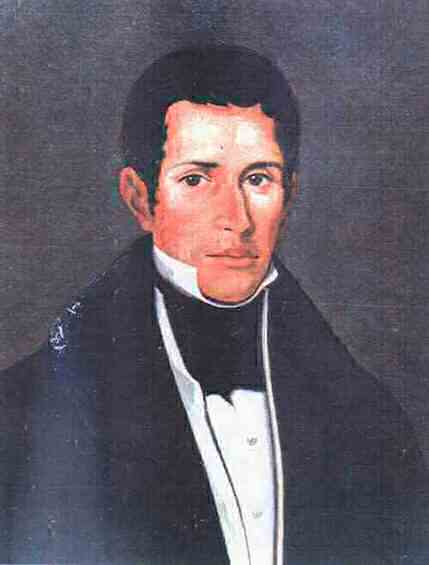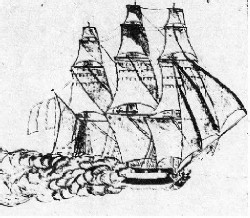A pirate is a thief on a ship, a privateer is a pirate licensed to steal from other countries’ ships, while a corsair is a French or Muslim privateer. (Oh, and a buccaneer was a hunter from Hispaniola who had turned pirate or privateer, but that’s another story.)
For the story behind the La Buse / Le Butin pirate cipher, it’s important to understand that while La Buse (Olivier Levasseur) was a pirate through and through, Le Butin (Bernardin Nageon de L’estang) seems to have been a nationalistic pirate who then turned official privateer before finally becoming a sailor in Napoleon’s Indian Ocean fleet (such as it was), where he died.
Specifically, Le Butin’s will (as described in Part 1) says “In my adventurous life before embarking on the Apollon, I was one of those pirates corsairs who did so much harm to our enemies Spain and England.”
At first, this didn’t mean much to me: but while reading “Forgotten Eden” (1968) by Athol Thomas, fragments of the larger story began to emerge. It turns out that the 16-gun Apollon (built in 1796) had been one of the most famous corsair ships in the Indian Ocean, because during a six month period in 1797 she captured over 700 million francs’ worth of treasure. Her illustrious captain was Jean François Hodoul whose grave at the Bel Air cemetery in the Seychelles’ Mahé Island sports (according to Thomas, though I haven’t been able to verify this) a carving of the Apollon.
The Apollon then passed from Hodoul to one of the other “Kings of the Corsairs”, Louis La Vaillant: there’s a line drawing of her from 1798:-
However, the Apollon’s shimmering career was then abruptly terminated by Captain Thomas Surridge on H.M.S. Leopard on 24th October 1798 (according to the London Gazette): the prize papers taken from the Apollon are HCA 49/13-5 at The National Archives in Kew (though these are marked as “1799”, perhaps the date they were archived).
By far the best account of the Apollon’s end I’ve found so far is from the extremely well-researched and well-informed Henri Maurel:-
A son retour à Port Louis, L’Apollon, dont Hodoul aurait possédé la moitié des parts, fut vendu au corsaire Le vaillant, qui en assura le commandement. L’Apollon appareilla pour une campagne le 22 Août 1798, captura une riche prise portugaise, puis fut lui-même arraisonné par le HMS Leopard, le 10 Novembre 1798, à environ 500 miles au NE de Mombasa, près de l’équateur et Longitude 45° 30′. Son équipage fut emmené à Anjouan, aux îles Comores, mais purent, plus tard, retourner à Maurice. Il est improbable qu’ Hodoul ait été parmi eux, en dépit de l’affirmation de Toussaint, comme officier en second. [xxii]
Si l’on considère la date de naissance du premier enfant de Hodoul, Raymond, le 20/06/1799, et “en comptant sur les doigts”, on arrive à la conclusion que son enfant avait été conçu en septembre 1798. Hodoul n’était donc pas à Bord de L’Apollon lors du départ de ce navire de Port Louis. Cet argument est conforté par deux éléments irréfutables: Un exemplaire du rôle d’équipage de L’Apollon retrouvé au Archives Départementales de la Réunion [xxiii], indique que le navire avait relâché dans cette île, certainement pour “faire le plein” de volontaires. La mention marginale en face du nom de Hodoul indique “à Prendre aux Seychelles”. L’Apollon n’ira point le chercher, car dans ses mémoires, le matelot Tabardin [xxiv], écrit ” … nous partons et nous voilà voguant sur les flots. Nous passâmes à Bourbon pour y prendre des volontaires, et continuant notre voyage, la première terre que nous vîmes fut la baie de Lagoa, ensuite celle de St Augustin; Puis nous dirigeâmes notre route vers Mozambique pour y établir notre croisière.” Hodoul échappa donc à cette fâcheuse aventure.
[xxii] Auguste Toussaint: Dictionnaire de Biographies Mauricienne.
[xxiii] Liasse L408
[xxiv] Mémoires de Tabardin, manuscrit, Carnegie Hall Curepipe Ile Maurice
My typical free’n’easy translation of Maurel’s text runs like this:-
On her return to Port Louis, the Apollon (which Hodoul had owned half the shares of) was sold to the corsair Louis La Vaillant, who also became her captain. The Apollon embarked on a new campaign on August 22nd 1798, captured a rich Portuguese ship, but was herself then taken by H.M.S. Leopard on November 10th 1798 about 500 miles NE of Mombasa near the equator, at Longitude 45° 30′. Her crew was brought to Anjouan in the Comoros Islands, but may later have returned to Mauritius. Despite the assertion to the contrary of Toussaint, the second officer, it is unlikely that Hodoul was among them. [xxii]
This is because if we count backwards ‘on our fingers’ from Hodoul’s first child Raymond’s date of birth (20th June 1799), we arrive at the conclusion that he was conceived in September 1798. Hence Hodoul was not on board at the start of the Apollon’s journey in Port Louis. This argument is strengthened by two irrefutable facts: (1) a copy of the crew list of Apollon found in the Archives Départementales de la Réunion [xxiii], which indicates that the vessel put in on the island, almost certainly to “fill up” its complement of volunteer seamen; and (2) the marginal note in front of Hodoul’s name indicates that he was “Taken to the Seychelles”. Apollon didn’t go looking for him at all because, as the sailor Tabardin [xxiv] wrote in his memoirs, “… we departed and straightaway we were sailing on the waves. We went to Bourbon [i.e. Reunion] to take on volunteers; and, continuing our journey, the first land we saw was Delagoa Bay, then on to St. Augustine’s Bay [in Madagascar]. After that we proceeded on our way towards Mozambique to get our cruise properly underway.” Hodoul thus escaped this unfortunate adventure.
Personally, this leaves me with little doubt that it was indeed the famous corsair ship Apollon that Le Butin served on: but under which captain – Hodoul or La Vaillant? I’m reasonably sure that it will turn out to be Le Vaillant, which is probably why Le Butin’s corsair career came to an end there: but perhaps a definite answer will be found in the crew list on Réunion, or in the prize papers at The National Archives.
Next step is to find enough time & money to get down there to see for myself (Réunion would be nice, sure, but I’ll probably have to settle for the bus fare to Kew & back, oh well!)… 🙂


Nick,
This, my latest discovery, may not have much to say about Le Butin, but you might find some discussion about French naval explorations in the early 1700’s which were precursors to Captain Cook’s explorations. Kinda fun making distinctions between explorers, privateers, pirates…..? With all of that traffic, how was any “treasure trove” kept secret?
Here’s my ref:
Time Life Books “The Sea Farers – The Pacific Navigators”
The book opens with a beautiful map (ca. 1570) and ends with, perhaps, an item of interest to you:
An oil painting of Jean-Francoise La Perouse unrolling a map of the Pacific for Louis XVI. A full-page discussion accompanies the illustration.
If I’ve completely blown your discussion off-course, just let me know with a yea or nay!
Admiringly yours,
bdid1dr
I realize I may be sailing even further away from your initial, la-buse-le-butin subject. But any mention of treasure associated with ship travel makes me want to mention one of the most famous recovery of ship-wreck treasure — in the 20th century:
Mel Fisher and his gang found the “Nuestra Senora de la Atocha” sunken off the Florida Keys. As far as I know, it is the largest Spanish treasure ever found in any century since it was lost. If I recall correctly, Mel spent years researching the Spanish archives. His find did come with severe personal loss, though; his son and daughter-in-law drowned when a piece of sieving equipment malfunctioned.
I guess the point I’m making is that if you’re being “blocked” in various areas of research, you may find a “treasure trove” of information in various Royal archives. Of course various historical museums, whether national or more “local”, usually also welcome “archive researchers” with open arms, if not overflowing file cabinets! (Just one of my several “hats” which I wore while working with various state, county, and city offices over a 25 year period of governmental desk clerical work.)
bdid1dr
Nick,
After the Mondragone meet, you mentioned
“Rafal Prinke’s news on Baresch & Sinapius”
wouldn’t mind a link if you’ve explained that in a later post.
Diane: there was talk that Rene Z was going to have all the presentations written up or published or something, but this seems not to have happened.
But the short version is that Rafal Prinke found a number of references to Jiri Bares (Georg Baresch), which helps cement the Voynich’s 17th century history yet further.
Brilliant! I expect it includes not a whisper of Rudolf-and-book?
Bd1dr
I realise that you do not like people to discuss or question things you choose to post on others’ blogs, but one thing I wonder – have you considered that even if you made a reasonable translation of the text, you would probably be totally ignored because you are nameless and for reasons which are probably clear to you, but which may need better explanation for others, you will not publish under your own name, on a blog of your own. Nor will you join the mailing list and ‘slog it out’ as most people have done in announcing a translation.
Truth to tell, people are quite likely to wonder whether you actually exist. Over the years there have been people posting under multiple personalities and in one case even a super-sophisticated mirror-bot.
If you have a viable translation, you owe it to yourself, at least, to publish your results ‘for real’.
D
Hi Nick,
I was in Reunion archives yesterday to check Le Vaillant’s Apollon crewlist. There isn’t any Bernardin nor Najeon nor l’Estang. The funny fact is that Le Vaillant writes in this folio that he set sail at Port Nord-Ouest (Port-Louis) the 5 fructidor year 6, and the morning after he found a dozen people in the ship which were not supposed to be there. So they were also put in the crew list.
The record L408 contains other fascinating items, for exemple the crewlist of the privateer Clarisse, signed by his captain, a certain Surcouf…
Another annoying point with Najeon letter is the fact that it cites Spain as an ennemy, but Spain have been allied to France from 1796 to 1810…
harlock: the Apollon crewlist is on my Cipher Foundation website, along with three depositions taken from the Prize Papers you probably haven’t seen 🙂 :
http://cipherfoundation.org/older-ciphers/le-butin-letters/apollon-crew-list/
http://cipherfoundation.org/older-ciphers/le-butin-letters/apollon-belcour-deposition
http://cipherfoundation.org/older-ciphers/le-butin-letters/apollon-godecheau-deposition
http://cipherfoundation.org/older-ciphers/le-butin-letters/apollon-tempie-deposition
Nick,
May be one day I’ll write something you don’t already know 😉
harlock: luckily there is plenty out there that I don’t know. 🙂
Do you have a list of the archives held on Réunion?
Some inventories could be find online here :
http://www.cg974.fr/culture/index.php/Archives/pr%C3%A9sentation-archives/les-fonds.html